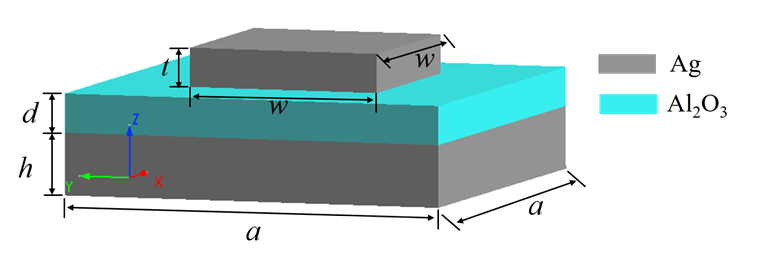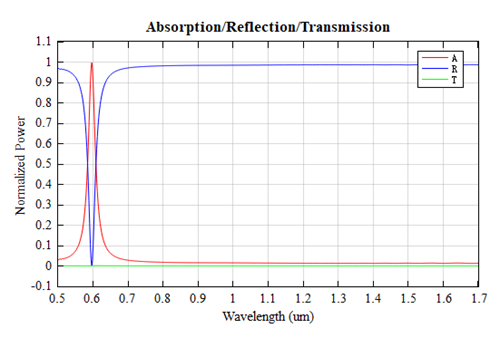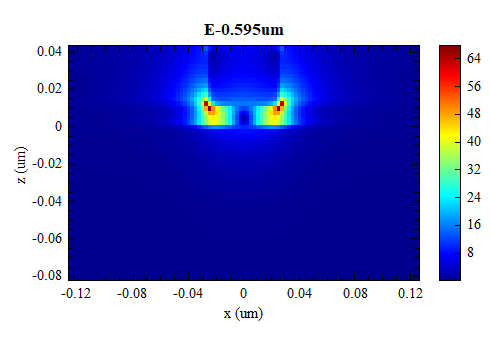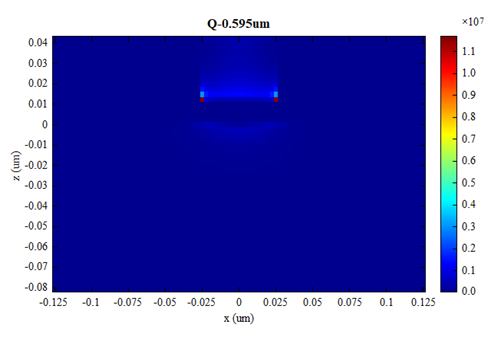Preface
"Metamaterial" is a special type of man-made material with extraordinary physical properties that natural materials do not have, such as regulating the frequency, amplitude, phase, etc. of electromagnetic waves. Metamaterials have a wide range of application prospects due to their exotic properties. For example, perfect absorbers designed based on metamaterials can be used as photodetectors, microbolometers, thermal imaging, etc. Based on the work of et al.[1], this case models and simulates a Metal-Insulator-Metal (MIM) plasma metamaterial infrared absorber to study its reflection/transmission/absorption characteristics in the visible to near-infrared band.
Simulation Setting
This case uses a MIM structure composed of silver-alumina-silver. The lower layer is an infinite flat plate of silver and aluminum oxide, and the upper layer is a periodic arrangement of silver cubes. The structure within one period is shown in the figure below. In optical simulation, we only need to simulate one cell. Due to the symmetry of the structure and plane wave source, we use Anti-Symmetric boundary conditions in the direction and Symmetric boundary conditions in the direction. We can reduce the simulation space and thus the simulation time by using symmetric and anti-symmetric boundary conditions.

| Parameters | |||||
|---|---|---|---|---|---|
| Size |
Material
The metal used in this case is the Ag material created using the Drude model. For specific details about the Drude model, see Debye, Drude, and Lorentz materials:
Among them, , plasma frequency , and collision frequency . The real and imaginary parts of the permittivity of Ag calculated by the Drude model are shown below.

Simulation Results
Reflectivity, transmissivity and absorptivity
Based on the T data obtained from the Frequency-Domain Field and Power(FDFP) monitors at the top and bottom of the MIM infrared absorber, the reflectivity (R), transmissivity (T), and absorptivity (A) of the absorber are plotted, as shown in the figure below. At a wavelength of around , the MIM infrared absorber's absorbance reaches a peak (over ), and this result is highly consistent with Figure 2 in the referenced literature.

Electric field and resistive heat distribution
The figure below shows the electric field distribution of the MIM infrared absorber at a wavelength of . It can be seen that an electric field enhancement effect occurs at the interface between the silver cube on the upper layer and the alumina. This is because the surface plasmon excitation resonance generated here traps the electric field in this small area.

The resistive heat formula is as follows:
Among them, is the speed of light, is the vacuum permittivity, is the imaginary part of the permittivity, and is the electric intensity. The resistive heat distribution diagram of the MIM infrared absorber at a wavelength of is as follows. It can be found that the resistive heat is mostly limited at the edges and corners of the interface between the Ag cube on the upper layer and the alumina. The high absorptivity causes most of the energy at this wavelength to be converted into heat energy through loss.

Reference
Hao J, Zhou L, Qiu M. Nearly total absorption of light and heat generation by plasmonic metamaterials[J]. Physical Review B Condensed Matter, 2011, 83(16):5919-5926. ↩︎






